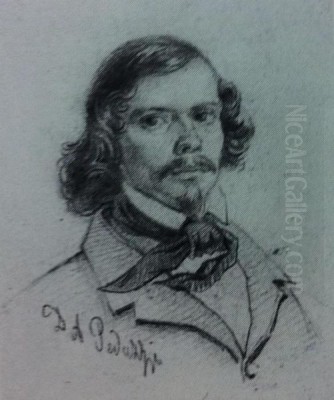
Hermanus Koekkoek the Elder stands as a significant figure in the rich tapestry of 19th-century Dutch art. Born in 1815 and passing away in 1882, he dedicated his artistic life primarily to the depiction of marine subjects, capturing the waterways, coasts, and maritime life of the Netherlands with remarkable skill and sensitivity. As a prominent member of the celebrated Koekkoek family, an artistic dynasty unparalleled in Dutch art history, Hermanus the Elder carved out his own niche, becoming one of the leading marine painters of the Dutch Romantic period. His work skillfully blends the observational accuracy inherited from the Dutch Golden Age with the evocative atmosphere and emotional depth characteristic of Romanticism.
His paintings, often depicting bustling harbours, tranquil estuaries, or ships navigating the challenging Dutch waters, resonated deeply with a nation proud of its maritime heritage. Hermanus Koekkoek the Elder not only achieved considerable success during his lifetime but also contributed significantly to the continuation of marine painting traditions in the Netherlands, influencing both his contemporaries and the subsequent generations of artists within his own remarkable family. His legacy endures through his finely crafted canvases, which continue to be admired in museums and private collections worldwide.
The Koekkoek Dynasty: A Foundation in Art
The story of Hermanus Koekkoek the Elder is inseparable from the extraordinary artistic family to which he belonged. The Koekkoek dynasty's artistic roots were firmly planted by his father, Johannes Hermanus Koekkoek (1778-1851). Born in Veere, Zeeland, Johannes Hermanus established himself as a respected painter specializing in marine views, river landscapes, and coastal scenes. His works often depicted sailing vessels, fishermen at work, and the distinctive Dutch estuaries, rendered with a keen eye for detail and atmospheric conditions, albeit generally in a calmer, more placid style than some of the later Romantics.
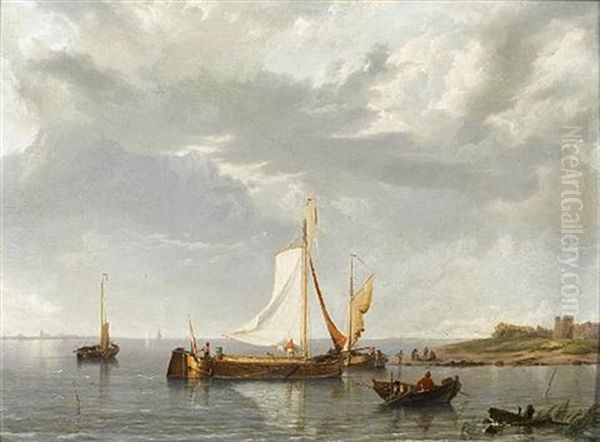
Johannes Hermanus was not only a successful artist in his own right but also the progenitor of a line of painters that would dominate certain genres of Dutch art for generations. He instilled a passion for art in his four sons, all of whom became accomplished painters: Barend Cornelis Koekkoek (1803-1862), Marinus Adrianus Koekkoek (1807-1868), Johannes Koekkoek (1811-1831), and the subject of this discussion, Hermanus Koekkoek the Elder (1815-1882). Growing up in this environment meant that art was not merely a profession but a way of life, with techniques, knowledge, and inspiration readily shared within the family circle. This familial artistic immersion provided an unparalleled foundation for Hermanus the Elder's own development.
Early Life and Artistic Formation
Hermanus Koekkoek was born on March 13, 1815, in Middelburg, the capital of the province of Zeeland. This location was significant; Middelburg, though past its Golden Age zenith, remained an important maritime and trading centre, providing the young Hermanus with constant exposure to the ships, harbours, and coastal landscapes that would become the bedrock of his artistic output. His primary artistic education came directly from his father, Johannes Hermanus. Under his father's tutelage, he learned the fundamentals of drawing, composition, and oil painting, focusing early on the marine subjects favoured by the elder Koekkoek.
While formal records are scarce, it is plausible that Hermanus, like his brothers, may have received some instruction or attended classes at the Middelburg Drawing Academy (Middelburgse Teekenacademie), where his father sometimes taught. However, the core of his training undoubtedly occurred within the family studio. This environment fostered a practical, hands-on approach to learning, emphasizing direct observation and the meticulous rendering techniques valued by his father. He absorbed the family's dedication to craftsmanship and the specific methods for depicting water, sky, and the intricate details of sailing vessels.
Seeking broader opportunities and a larger market, Hermanus Koekkoek the Elder eventually moved from Middelburg to the bustling metropolis of Amsterdam around 1832. Amsterdam, with its major port, thriving art scene, and numerous potential patrons, offered a more dynamic environment for an ambitious marine painter. This move proved pivotal, allowing him to establish his reputation and develop his mature style amidst the leading artistic currents of the time. He remained based primarily in Amsterdam for much of his productive career, though he also worked in Nieuwer-Amstel (now Amstelveen) and spent his final years in Haarlem.
Artistic Style: Romanticism Meets Realism
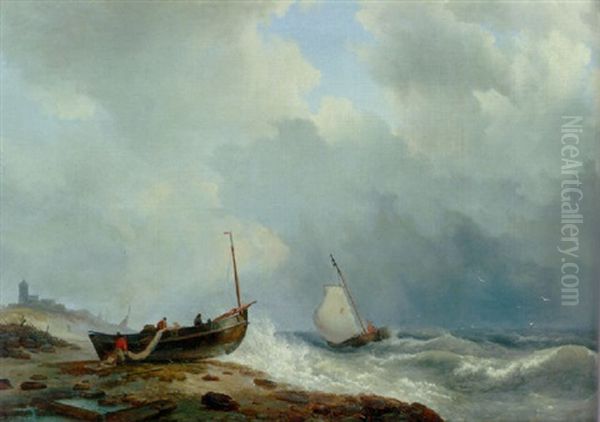
Hermanus Koekkoek the Elder's art is best understood as belonging to the Dutch Romantic movement, yet it retains strong ties to the realistic traditions of the 17th-century Dutch Golden Age. Dutch Romanticism, emerging in the early 19th century, often looked back to the Golden Age for inspiration, particularly in landscape and marine painting. It emphasized atmosphere, the power and beauty of nature, and often carried undertones of national pride, especially relevant in the Netherlands following the Napoleonic era and the Belgian secession.
Koekkoek masterfully blended these elements. His work shows the clear influence of Golden Age marine specialists like Willem van de Velde the Elder (1611-1693) and Willem van de Velde the Younger (1633-1707) in the accurate depiction of ships, rigging, and nautical details. The dramatic compositions and rendering of turbulent seas seen in the work of Ludolf Bakhuizen (1630-1708) also find echoes in some of Koekkoek's more dynamic pieces. Furthermore, the atmospheric sensitivity and nuanced handling of light, particularly in calmer scenes, recall painters like Jan van Goyen (1596-1656) and Salomon van Ruysdael (c. 1600/03–1670), although the latter were primarily landscape painters, their treatment of water and sky was influential. The dramatic landscape sensibilities of Jacob van Ruisdael (c. 1628/29–1682), who also painted seascapes, can be seen as another precursor.
However, Koekkoek was not merely an imitator. He infused his works with a distinctly 19th-century Romantic sensibility. This is evident in his heightened attention to mood and atmosphere, whether depicting the tranquility of a calm dawn or the drama of an approaching squall. His skies are often active participants in the scene, with carefully rendered cloud formations and subtle gradations of light playing across the water's surface. While maintaining topographical accuracy in his harbour views and coastal profiles, he often imbued his scenes with a sense of idealized beauty or gentle melancholy.
His technique was characterized by fine, controlled brushwork, allowing for meticulous detail in the rendering of ships, figures, and architectural elements. He employed a typically Dutch palette, favouring naturalistic blues, greys, greens, and earth tones, but used them with great subtlety to achieve convincing effects of light and distance. Small figures often populate his scenes – fishermen, sailors, merchants – adding narrative interest and providing a sense of scale against the vastness of the sea and sky. This careful balance between detailed realism and evocative Romanticism became the hallmark of his style.
Master of the Marine View
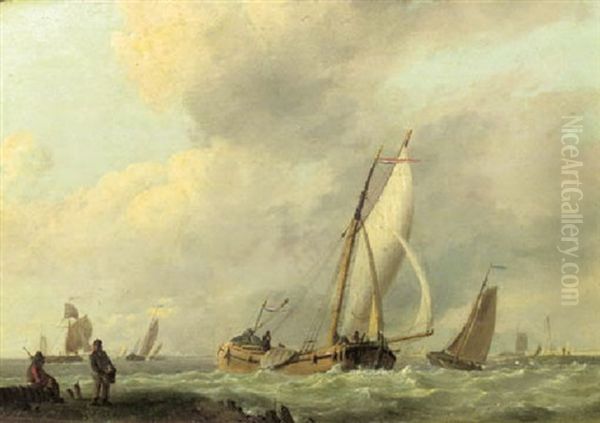
Throughout his career, Hermanus Koekkoek the Elder remained steadfastly dedicated to marine and river subjects. His oeuvre encompasses a wide range of scenes related to the water, reflecting the Netherlands' intimate relationship with the sea. He painted views of major harbours like Amsterdam and Rotterdam, busy estuaries filled with shipping traffic, tranquil inland waterways, and expansive coastal vistas under various weather conditions. Fishing boats (bomschuiten, pinken), merchant vessels (koffs, tjalks), and sometimes naval ships are depicted with an expert understanding of their construction and behaviour in the water.
His ability to capture the specific character of Dutch waters and skies was highly praised. He excelled at rendering the effects of light on water, from the glassy reflections on a calm surface to the choppy, white-capped waves of a breezy day. The interplay between water and sky is central to his compositions, often featuring low horizons that emphasize the vastness of the heavens, filled with dynamic cloud formations that dictate the scene's mood. Whether depicting the silvery light of morning, the warm glow of late afternoon, or the dramatic contrasts of stormy weather, his handling of atmosphere is consistently masterful.
These paintings were more than just accurate representations; they tapped into a deep vein of Dutch national identity. In the 19th century, the sea still represented both the source of the nation's historic prosperity and a powerful, sometimes dangerous, force of nature. Koekkoek's works celebrated Dutch maritime prowess and the everyday lives of those who worked on the water, resonating with collectors who saw in them a reflection of their nation's character and history. His scenes often convey a sense of quiet industry and resilience, portraying the harmonious, yet respectful, relationship between humanity and the sea.
Notable Works: Capturing the Dutch Waters
Several specific works exemplify Hermanus Koekkoek the Elder's style and subject matter. Ships on a Calm Sea, dated 1847, is a quintessential example of his tranquil scenes. It depicts various sailing vessels resting on placid waters, likely near the coast, under a soft, luminous sky. The meticulous rendering of the ships, the subtle reflections in the water, and the overall sense of peace are characteristic of his mastery in capturing calm conditions. The relatively small dimensions (27 x 40 cm) suggest it was likely intended for intimate viewing in a domestic setting.
A Calm Harbour Scene from 1858 (55.6 x 74.5 cm) presents a more complex composition, likely depicting a specific Dutch port. Such works allowed Koekkoek to showcase his skill in rendering not only ships and water but also quayside architecture, bustling human activity, and the interplay of light and shadow within a harbour environment. These scenes often highlight the commercial lifeblood of the nation.
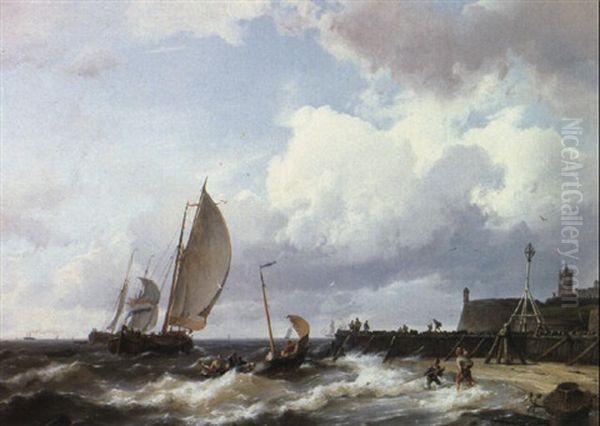
While primarily known for seascapes, works like Fisherman's Cottage in the Dunes demonstrate his ability to capture coastal life beyond the water itself. Such paintings often focus on the atmospheric conditions of the dunes, perhaps with the sea visible in the distance, showcasing his versatility and his skill in rendering different textures and light effects, such as sunlight breaking through clouds.
Other typical titles found in his oeuvre include Shipping Vessels at an Estuary and Sailing in a Light Breeze. The former points to his frequent depiction of the wide river mouths characteristic of the Dutch landscape, often showing a mix of sea-going and inland vessels. The latter highlights his sensitivity to specific weather conditions, capturing the gentle movement of ships propelled by a mild wind, requiring a nuanced understanding of sail dynamics and water movement. While dramatic shipwrecks were a popular theme in Romanticism, and depicted by his father Johannes Hermanus, Hermanus the Elder seems to have more frequently favoured calmer or moderately active scenes, emphasizing the beauty and daily life associated with the Dutch waters.
Peers and Contemporaries: The Dutch Art Scene
Hermanus Koekkoek the Elder worked during a vibrant period in Dutch art. His most immediate artistic context was, of course, his own family. His father, Johannes Hermanus Koekkoek, was his first teacher and a constant reference point. His elder brother, Barend Cornelis Koekkoek, became the most celebrated Dutch landscape painter of the Romantic era, often called the "Prince of Landscape Painters." While Barend Cornelis focused on wooded landscapes, often inspired by his travels in Germany, his meticulous technique and romantic sensibility paralleled Hermanus's approach to marine subjects. B.C. Koekkoek himself was influenced by the leading landscape painter Andreas Schelfhout (1787-1870).
Another brother, Marinus Adrianus Koekkoek, also painted landscapes and occasionally marine scenes, sharing the family's commitment to detailed realism and atmospheric effect. The tragically short-lived Johannes Koekkoek also showed promise as a painter. This intense familial network of artists created both support and, presumably, a degree of friendly competition.
Beyond his family, Hermanus the Elder was part of a broader school of Dutch Romantic marine painting. Perhaps the most significant figure alongside him in this field was Johannes Christiaan Schotel (1787-1838). Although Schotel belonged to a slightly earlier generation, his dramatic and skillfully executed seascapes set a high standard and certainly influenced Hermanus. Other notable contemporaries specializing in marine or coastal views included Louis Meijer (1809-1866), known for his often more dramatic and internationally oriented seascapes, and Johannes Frederik Hulk Snr. (1829-1911), who also painted marine and harbour scenes.
While Hermanus focused on the sea, the broader Dutch Romantic art scene included prominent landscape painters like Andreas Schelfhout and Wijnand Nuijen (1813-1839), and highly successful cityscape painters such as Cornelis Springer (1817-1891). Although their subject matter differed, these artists shared a common grounding in detailed observation combined with a Romantic appreciation for atmosphere and national scenery. Later in Hermanus's life, the Hague School began to emerge, shifting towards a looser, more tonal style of realism, represented by artists like Hendrik Willem Mesdag (1831-1915), who would become the next dominant force in Dutch marine painting.
The Next Generation: Continuing the Legacy
Hermanus Koekkoek the Elder played a crucial role in transmitting the family's artistic legacy to the next generation. He fathered several sons who also became painters, ensuring the Koekkoek name remained prominent in the Dutch art world well into the late 19th and early 20th centuries. His most direct artistic heir in terms of subject matter was Hermanus Koekkoek the Younger (1836-1909). Trained by his father, Hermanus the Younger largely followed in his footsteps, specializing in marine paintings and river views, often in a style very similar to his father's, which can sometimes lead to confusion in attribution. He even spent considerable time working in London, reflecting the international appeal of this style.
Another son, Willem Koekkoek (1839-1895), diverged in subject matter, becoming highly successful and renowned for his meticulously detailed Dutch cityscapes, often romanticized views of 17th-century streets and canals. While the subject differed, the precision and atmospheric quality clearly owed a debt to the family tradition established by his grandfather and father.
Johannes Hermanus Barend Koekkoek (1840-1912), often known as Jan H.B. Koekkoek, also became a painter, focusing on marine subjects and coastal scenes, particularly favouring depictions of fishing boats and fisherfolk along the shore. His style often showed influences leaning towards the Hague School later in his career. A fourth son, Hendrik Barend Koekkoek (1849-c.1909), primarily painted landscapes, continuing the other major strand of the family's artistic output. The continuation of the artistic tradition through his sons underscores Hermanus the Elder's significance not just as an individual artist, but as a vital link in the Koekkoek dynasty.
Later Years and Enduring Reputation
Hermanus Koekkoek the Elder continued to paint actively throughout his life, exhibiting his works regularly in Amsterdam, The Hague, Rotterdam, and other Dutch cities, as well as internationally. His paintings found favour with collectors both in the Netherlands and abroad, particularly in Great Britain, Germany, and the United States, where the combination of Dutch realism and accessible Romanticism was highly appreciated. He maintained a high standard of quality, and his reputation as a leading marine specialist remained solid.
In his later years, he moved from Amsterdam, residing for a time in Nieuwer-Amstel before settling in Haarlem, another city with a rich artistic history. He passed away in Haarlem on November 5, 1882, at the age of 67. By the time of his death, the artistic tides were already turning towards the looser brushwork and tonal palettes of the Hague School, yet the appeal of Koekkoek's finely rendered, atmospheric marine views endured.
Today, Hermanus Koekkoek the Elder's works are held in numerous public collections, including the Rijksmuseum in Amsterdam, the Teylers Museum in Haarlem, Museum Boijmans Van Beuningen in Rotterdam, and various regional museums in the Netherlands, as well as museums internationally. His paintings continue to be sought after on the art market, admired for their technical proficiency, evocative beauty, and their quintessential representation of Dutch maritime life during the Romantic era. He successfully navigated the artistic currents of his time, honouring the legacy of the Golden Age while forging a distinctive Romantic style that secured his place as a master of Dutch marine painting.
Conclusion
Hermanus Koekkoek the Elder occupies a distinguished position in 19th-century Dutch art history. As a leading marine painter of the Romantic period, he skillfully synthesized the meticulous realism inherited from the Dutch Golden Age masters with the atmospheric sensitivity and emotional resonance of his own era. His lifelong dedication to depicting the seas, rivers, and harbours of the Netherlands resulted in an oeuvre celebrated for its technical brilliance, compositional harmony, and evocative portrayal of maritime life.
His role within the remarkable Koekkoek dynasty was pivotal. Trained by his father, Johannes Hermanus, he became a master in his own right and, in turn, passed on the artistic mantle to his sons, ensuring the family's continued prominence. Working alongside esteemed contemporaries like Johannes Christiaan Schotel and within the broader context of Dutch Romanticism, Hermanus the Elder created works that not only captured the visual reality of the Dutch waterscape but also resonated with the national pride and identity tied to the sea. His paintings remain a testament to his skill and vision, offering enduringly beautiful glimpses into the maritime world of the 19th-century Netherlands.